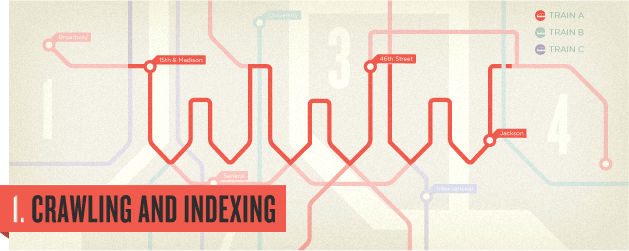Every search engine has three main functions: crawling (to discover content), indexing (to track and store content), and retrieval (to fetch relevant content when users query the search engine).
But how is a website crawled? An automated bot (called a “spider”) visits page after page as quickly as possible, using page links to find where to go next. Even in the earliest days, Google’s spiders could read several hundred pages per second. Nowadays, it’s in the thousands.

When a web crawler visits a page, it collects every link on the page and adds them to its list of next pages to visit. It goes to the next page in its list, collects the links on that page, and repeats. Web crawlers also revisit past pages once in a while to see if any changes happened.
This means any site that’s linked from an indexed site will eventually be crawled. Some sites are crawled more frequently, and some are crawled to greater depths, but sometimes a crawler may give up if a site’s page hierarchy is too complex.
One way to understand how a web crawler works is to build one yourself. We’ve written a tutorial on creating a basic web crawler in PHP, so check that out if you have any programming experience.

Imagine making a list of all the books you own, their publishers, their authors, their genres, their page counts, etc. Crawling is when you comb through each book while indexing is when you log them to your list.
Now imagine it’s not just a room full of books, but every library in the world. That’s a small-scale version of what Google does, who stores all of this data in vast data centers with thousands of petabytes worth of drives.
Retrieval is when the search engine processes your search query and returns the most relevant pages that match your query.
Most search engines differentiate themselves through their retrieval methods: they use different criteria to pick and choose which pages fit best with what you want to find. That’s why search results vary from Google and Bing.
Ranking algorithms check your search query against billions of pages to determine each one’s relevance. Companies guard their ranking algorithms as patented industry secrets due to their complexity. A better algorithm translates to a better search experience.
They also don’t want web creators to game the system and unfairly climb to the tops of search results. If the internal methodology of a search engine ever got out, all kinds of people would surely exploit that knowledge to the detriment of searchers like you and me.

Search engine exploitation is possible, of course, but isn’t so easy anymore.
Originally, search engines ranked sites by how often keywords appeared on a page, which led to “keyword stuffing” — filling pages with keyword-heavy nonsense.
Then came the concept of link importance: search engines valued sites with lots of incoming links because they interpreted site popularity as relevance. But this led to link spamming all over the web. Nowadays, search engines weight links depending on the “authority” of the linking site. Search engines put more value on links from a government agency than links from a link directory.
Today, ranking algorithms are shrouded in more mystery than ever before, and “search engine optimization” isn’t so important. Good search engine rankings now come from high-quality content and great user experiences.
Crawling
Crawling is where it all begins: the acquisition of data about a website.
This involves scanning sites and collecting details about each page: titles, images, keywords, other linked pages, etc. Different crawlers may also look for different details, like page layouts, where advertisements are placed, whether links are crammed in, etc.But how is a website crawled? An automated bot (called a “spider”) visits page after page as quickly as possible, using page links to find where to go next. Even in the earliest days, Google’s spiders could read several hundred pages per second. Nowadays, it’s in the thousands.
This means any site that’s linked from an indexed site will eventually be crawled. Some sites are crawled more frequently, and some are crawled to greater depths, but sometimes a crawler may give up if a site’s page hierarchy is too complex.
One way to understand how a web crawler works is to build one yourself. We’ve written a tutorial on creating a basic web crawler in PHP, so check that out if you have any programming experience.
Note that pages can be marked as “noindex,” which is like asking search engines to skip its indexing. Non-indexed parts of the internet are known as the “deep web”, and some sites, like those hosted on the TOR network, can’t be indexed by search engines. (What are TOR and onion routing?)
Indexing
Indexing is when the data from a crawl is processed and placed in a database.
Imagine making a list of all the books you own, their publishers, their authors, their genres, their page counts, etc. Crawling is when you comb through each book while indexing is when you log them to your list.
Now imagine it’s not just a room full of books, but every library in the world. That’s a small-scale version of what Google does, who stores all of this data in vast data centers with thousands of petabytes worth of drives.
Retrieval and Ranking
Retrieval is when the search engine processes your search query and returns the most relevant pages that match your query.
Most search engines differentiate themselves through their retrieval methods: they use different criteria to pick and choose which pages fit best with what you want to find. That’s why search results vary from Google and Bing.
Ranking algorithms check your search query against billions of pages to determine each one’s relevance. Companies guard their ranking algorithms as patented industry secrets due to their complexity. A better algorithm translates to a better search experience.
They also don’t want web creators to game the system and unfairly climb to the tops of search results. If the internal methodology of a search engine ever got out, all kinds of people would surely exploit that knowledge to the detriment of searchers like you and me.
Originally, search engines ranked sites by how often keywords appeared on a page, which led to “keyword stuffing” — filling pages with keyword-heavy nonsense.
Then came the concept of link importance: search engines valued sites with lots of incoming links because they interpreted site popularity as relevance. But this led to link spamming all over the web. Nowadays, search engines weight links depending on the “authority” of the linking site. Search engines put more value on links from a government agency than links from a link directory.
Today, ranking algorithms are shrouded in more mystery than ever before, and “search engine optimization” isn’t so important. Good search engine rankings now come from high-quality content and great user experiences.





